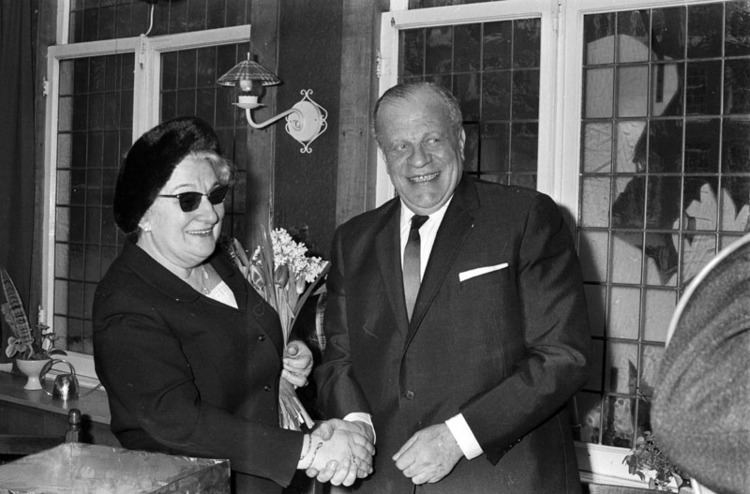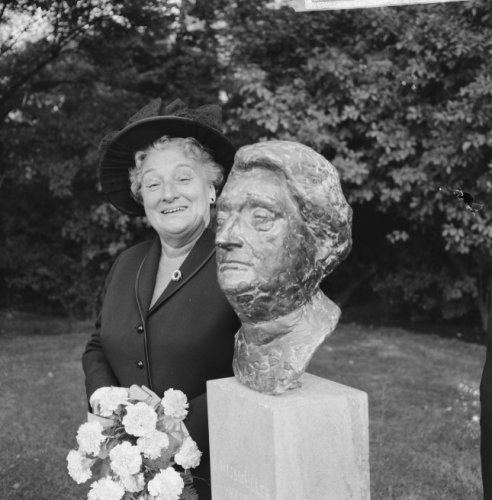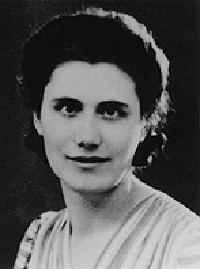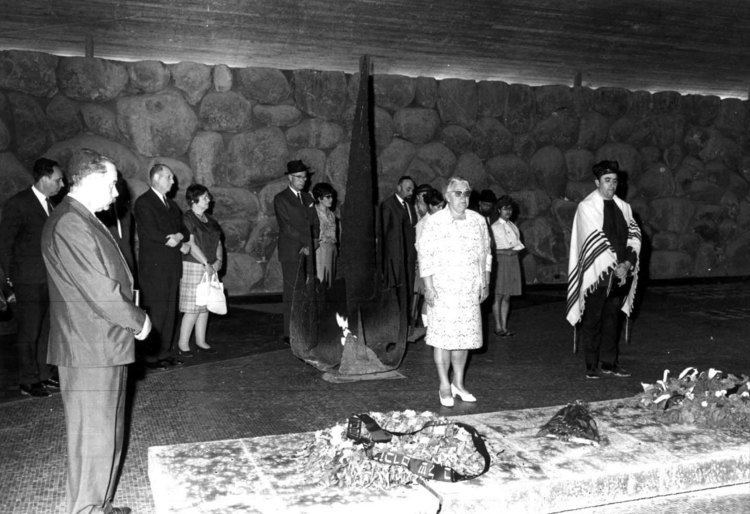 | ||
Name Geertruida Wijsmuller-Meijer Died August 30, 1978, Amsterdam, Netherlands | ||
Geertruida Wijsmuller-Meijer (21 April 1896, Alkmaar – 30 August 1978, Amsterdam) was a Dutch war hero, resistance fighter, and probably after Raoul Wallenberg and Aristides de Sousa Mendes the greatest savior of Jews. She was recognized as Righteous among the Nations by Yad Vashem. In all likelihood, she, together with others involved with Kindertransport, saved more than 10,000 Jewish children.
Contents

Early life

Geertruida Meijer's parents owned a drugstore in Alkmaar, where she also attended the School of Commerce. Her parents taught her to "always help those people who really deserve and need it, no matter the colour of their skin or their religion", she would later recall. After World War I her parents fostered weak and hungry Austrian children in their home. In 1912, the family moved to Duivendrecht.

Two years later she got her first job at a bank where she met her husband, banker J. F. Wijsmuller (born in Amsterdam on 25 February 1894); they married in 1923. When it became clear that she could not have children, Wijsmuller-Meijer decided to become involved in social work, which ultimately led to her rescuing Jewish children.
Kindertransport

She was a friend of resistance fighter Mies Boissevain-van Lennep, whom she knew from the Association for Women's Interests and Equal Citizenship (VVGS). From the 1930s onward, "Auntie Truus" (as they soon called her) arranged, with Mies Boissevain and others, children's transports for the Committee for Special Jewish Interests (Dutch: Comité voor Bijzondere Joodsche Belangen - CBJB). These transports saved 10,000 Jewish children from Germany and Austria, on a route via the Netherlands to the UK.

In Germany she worked with Recha Freier, the wife of a Berlin rabbi. She was not intimidated easily, made a fuss if necessary, bribed railroad men with gifts and German officers with charm. She negotiated with the man who would later organize the transports of Jews to Auschwitz and other concentration camps, Adolf Eichmann, who was working in Vienna at the time. Eichmann joked with her: no negotiation, she could take 600 Viennese Jewish children immediately. In the following days she took them to Hook of Holland, from where five hundred of them immediately traveled to Great Britain. The remaining hundred children were given shelter in The Hague. After this, transports became more structured and a maximum of 150 children per transport was agreed. She traveled to Germany several times a week to pick them up. The invasion of the Netherlands put a stop to these transports, as the borders to the UK were closed from that point onwards.
Wijsmuller-Meijer was in Paris when she heard of the German invasion of the Netherlands. She traveled back to Amsterdam as soon as she could. In Amsterdam the garrison commander asked her to take the Jewish children from the orphanage to the coastal town of IJmuiden, so they could still get on a boat to England. She picked up a number of children on the way, bringing the total to 74 children. She arranged a place on the last boat ("SS Bodegraven") to leave the harbor. Wijsmuller-Meijer decided to stay in the Netherlands with her husband. The Bodegraven was the same ship on which the famous art dealer Jacques Goudstikker and his family traveled to England (where Goudstikker was killed by an accident). The ship sailed for England, but due to the German nationality of the children, they were not allowed to come ashore. The ship sailed on to Belfast, but eventually moored on 19 May at Liverpool.
The children spent the war in institutions or with families in England. During the occupation, Wijsmuller-Meijer continued to help Jews out of the country.
Work
During the occupation she continued her now illegal rescue operations. For the Dutch Red Cross she brought packets to refugee camps in southern France. When possible she took Jewish children and smuggled them to Vichy France or Spain. In 1942 she was briefly arrested by the Gestapo in the Amstelveenseweg in Amsterdam. The Gestapo suspected her – rightly – of planning to smuggle dozens of Jews to Switzerland, but they had to release her because of lack of evidence and because "Auntie Truus" did not provide them with any relevant information.
As the war progressed, she devoted herself to obtaining and distributing food. She sent thousands of packages to camps like Westerbork and Theresienstadt, and delivered duck eggs to elderly houses in Amsterdam every week. During the Dutch famine of 1944 (the Hongerwinter or "Hunger winter") she took care of malnourished children in the Randstad. She took many across the IJsselmeer to more rural areas like Groningen, Friesland, Overijssel and Drenthe to recuperate.
After the war, from 1945 until 1966, she was a member of the Amsterdam city council, for the liberal party VVD. She was also involved in the creation of workplaces for the disabled. She was a board member of the Anne Frank House. An obituary after her death summarized her life as follows: "Mother of 1001 children, who made rescuing Jewish children her life's work."
